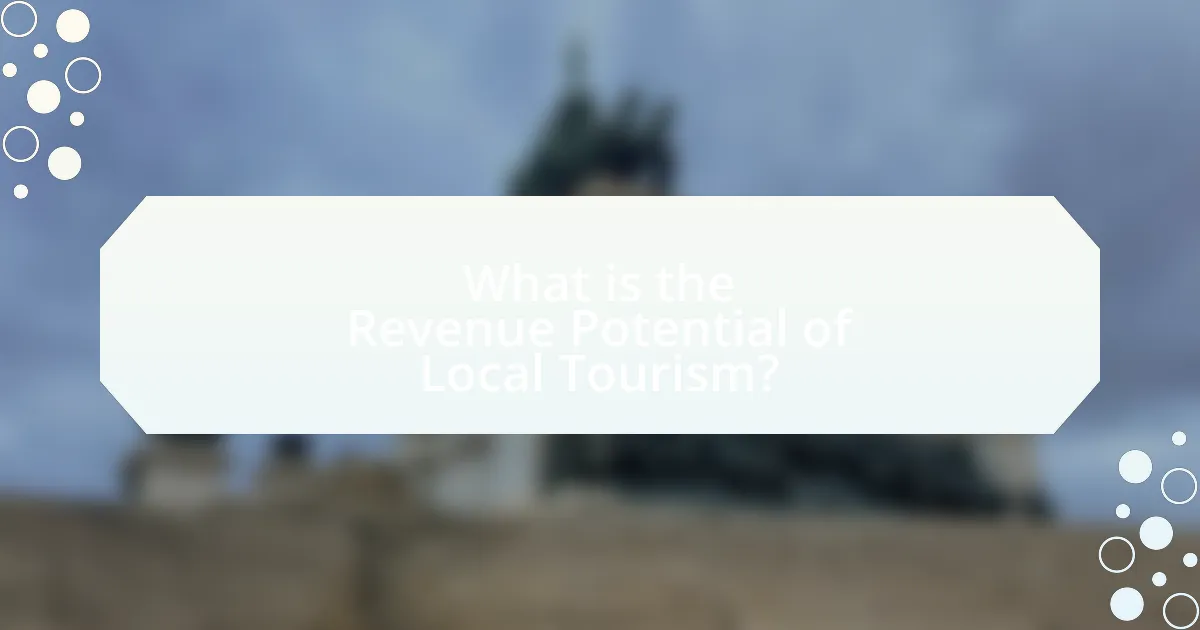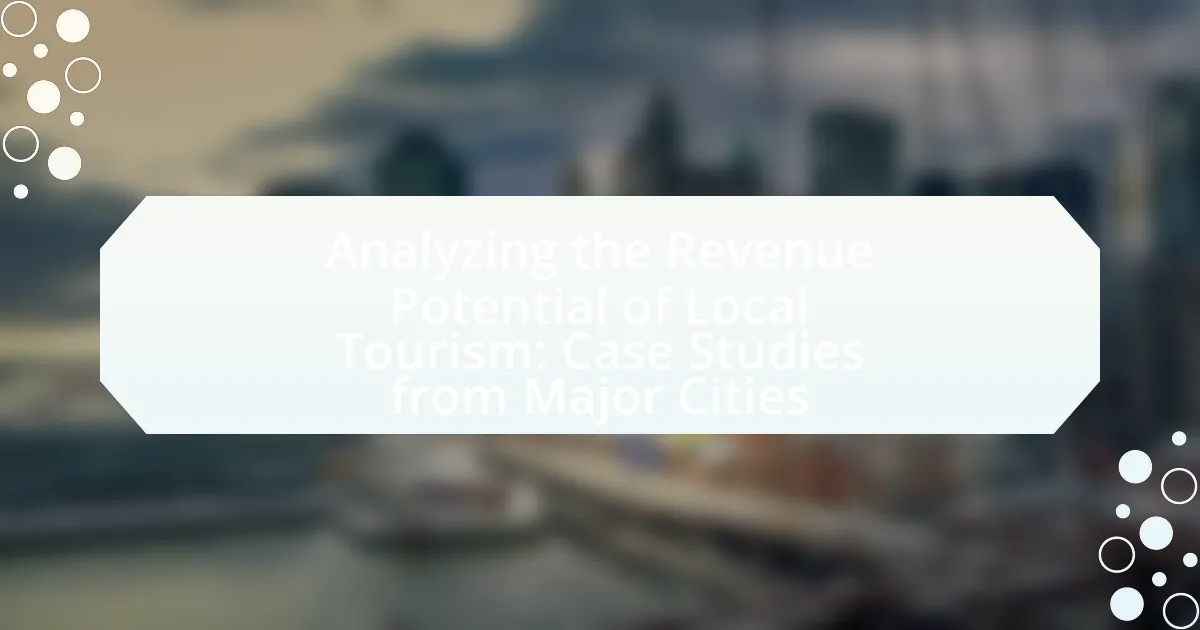The article focuses on the revenue potential of local tourism, highlighting its significant contribution to local economies, with U.S. domestic tourism spending reaching approximately $972 billion in 2019. It defines local tourism as the economic activity generated by visitors within a specific region, emphasizing key components such as accommodations, attractions, food services, and retail that drive revenue. The article analyzes case studies from major cities like New York, Paris, and Tokyo, showcasing successful strategies for maximizing tourism revenue through effective marketing, infrastructure investment, and community engagement. Additionally, it discusses the challenges cities face in optimizing tourism revenue and the role of technology and data analytics in enhancing decision-making and forecasting.

What is the Revenue Potential of Local Tourism?
The revenue potential of local tourism is significant, with estimates indicating that it can contribute billions of dollars to local economies. For instance, in 2019, domestic tourism spending in the United States reached approximately $972 billion, highlighting the substantial financial impact of local tourism. This spending supports various sectors, including hospitality, retail, and transportation, creating jobs and stimulating economic growth. Additionally, cities that invest in local tourism infrastructure often see a return on investment through increased visitor numbers and spending, further validating the revenue potential of this sector.
How is local tourism defined in the context of revenue generation?
Local tourism is defined as the economic activity generated by visitors who travel within a specific region, contributing to revenue through expenditures on accommodations, dining, attractions, and services. This form of tourism plays a crucial role in local economies, as it stimulates job creation and supports local businesses. For instance, according to the U.S. Travel Association, domestic travelers spent over $1 trillion in 2019, highlighting the significant impact of local tourism on revenue generation.
What are the key components that contribute to local tourism revenue?
Key components that contribute to local tourism revenue include accommodation, attractions, food and beverage services, transportation, and retail. Accommodation generates revenue through hotel stays, vacation rentals, and hostels, which collectively accounted for approximately $200 billion in the U.S. in 2019. Attractions, such as museums, parks, and events, draw visitors and can significantly boost local economies; for instance, the National Park Service reported that visitors to national parks contributed over $18 billion to local economies in 2020. Food and beverage services, including restaurants and cafes, also play a crucial role, with the National Restaurant Association estimating that the restaurant industry alone generated $899 billion in sales in 2020. Transportation services, including taxis, rideshares, and public transit, facilitate visitor movement and contribute to local revenue streams. Lastly, retail sales from souvenirs and local products enhance tourism revenue, with a study indicating that tourists spend about 30% of their travel budget on shopping. These components collectively create a robust framework for local tourism revenue generation.
How do local attractions influence tourism revenue?
Local attractions significantly influence tourism revenue by drawing visitors who spend money on various services and products. For instance, attractions such as museums, parks, and historical sites create a demand for accommodations, dining, and transportation, which collectively contribute to the local economy. According to a report by the U.S. Travel Association, domestic and international travelers spent over $1 trillion in the United States in 2019, with a substantial portion attributed to visits to local attractions. This spending supports jobs and generates tax revenue, further enhancing the economic impact of tourism in major cities.
Why is analyzing revenue potential important for cities?
Analyzing revenue potential is crucial for cities because it enables informed decision-making regarding resource allocation and economic development. By understanding the revenue potential, cities can identify key sectors, such as tourism, that contribute significantly to their economies. For instance, cities that effectively analyze tourism revenue potential can implement targeted marketing strategies, optimize infrastructure investments, and enhance visitor experiences, ultimately leading to increased economic growth. Research indicates that cities with robust tourism strategies can see revenue increases of up to 20%, demonstrating the tangible benefits of such analyses.
What economic benefits does local tourism provide to cities?
Local tourism provides significant economic benefits to cities, primarily through increased revenue generation. This revenue comes from various sources, including hotel stays, dining, entertainment, and retail purchases made by tourists. For instance, cities like New Orleans reported that tourism contributed over $9 billion to the local economy in 2019, supporting more than 86,000 jobs. Additionally, local tourism stimulates job creation in sectors such as hospitality and transportation, further enhancing economic stability. Furthermore, taxes generated from tourism-related activities contribute to public services and infrastructure development, which can improve the overall quality of life for residents.
How does local tourism impact job creation and local businesses?
Local tourism significantly impacts job creation and local businesses by generating employment opportunities and increasing revenue for various sectors. When tourists visit a locality, they require services such as accommodation, dining, transportation, and entertainment, which leads to the creation of jobs in these industries. For instance, a report from the U.S. Travel Association indicates that in 2019, travel and tourism supported 9.5 million jobs in the United States alone, showcasing the sector’s role in employment.
Additionally, local businesses benefit from increased consumer spending as tourists purchase goods and services, which can lead to higher sales and profits. According to the World Travel & Tourism Council, in 2019, the travel and tourism sector contributed $2.9 trillion to the global economy, highlighting its importance in driving local business growth. This influx of tourism revenue can also stimulate further investment in infrastructure and services, creating a positive feedback loop that enhances the overall economic health of the community.
What factors affect the revenue potential of local tourism?
The revenue potential of local tourism is primarily affected by factors such as destination attractiveness, accessibility, marketing efforts, and local infrastructure. Destination attractiveness includes natural beauty, cultural heritage, and recreational activities, which draw visitors. Accessibility refers to the ease of reaching the destination, including transportation options and proximity to major urban centers. Effective marketing efforts can significantly enhance visibility and appeal, influencing tourist decisions. Local infrastructure, including accommodations, dining options, and amenities, directly impacts the visitor experience and spending. For instance, cities with well-developed tourism infrastructure, such as Paris, generate higher revenue due to increased visitor satisfaction and longer stays.
How do seasonal trends influence tourism revenue?
Seasonal trends significantly influence tourism revenue by dictating the flow of visitors to destinations at different times of the year. For instance, peak seasons, such as summer and winter holidays, often see a surge in tourist arrivals, leading to increased spending on accommodations, dining, and attractions. According to the U.S. Travel Association, domestic travel spending in the United States reached $1.1 trillion in 2019, with summer months accounting for a substantial portion of this revenue due to favorable weather and school vacations. Conversely, off-peak seasons typically experience lower visitor numbers, resulting in decreased revenue for local businesses. This cyclical pattern underscores the importance of understanding seasonal trends for effective tourism planning and revenue forecasting.
What role does marketing play in enhancing local tourism revenue?
Marketing plays a crucial role in enhancing local tourism revenue by effectively promoting destinations, attractions, and experiences to potential visitors. Through targeted advertising, social media campaigns, and partnerships with local businesses, marketing increases visibility and attracts tourists, which directly contributes to higher spending in the local economy. For instance, a study by the U.S. Travel Association found that every $1 spent on travel and tourism marketing generates approximately $3.50 in economic output, highlighting the significant return on investment for local tourism initiatives.

What are the Case Studies from Major Cities?
Case studies from major cities analyzing the revenue potential of local tourism include New York City, Paris, and Tokyo. In New York City, tourism generated approximately $70 billion in economic impact in 2019, with over 66 million visitors contributing to the local economy. Paris, known for its cultural attractions, saw around 38 million international visitors in 2019, resulting in significant revenue from hospitality and retail sectors. Tokyo, hosting the 2020 Olympics, aimed to attract 40 million visitors by 2020, projecting a substantial boost in tourism-related revenue. These examples illustrate how major cities leverage tourism to enhance their economic landscape.
Which major cities have successfully analyzed their local tourism revenue potential?
Major cities that have successfully analyzed their local tourism revenue potential include New York City, London, and Barcelona. New York City utilized the NYC & Company report, which estimated that tourism contributed over $70 billion to the local economy in 2019. London’s analysis by VisitBritain indicated that tourism generated £22.9 billion in 2019, showcasing its significant economic impact. Barcelona’s tourism strategy, supported by the Barcelona Tourism Board, revealed that the sector accounted for approximately 14% of the city’s GDP, emphasizing the importance of tourism revenue analysis in urban planning and economic development.
What methodologies did these cities use for their analysis?
The cities employed a combination of quantitative and qualitative methodologies for their analysis. Quantitative methods included statistical modeling and data analysis of tourism revenue, visitor demographics, and economic impact assessments, often utilizing data from local tourism boards and economic reports. Qualitative methods involved stakeholder interviews and surveys to gather insights from local businesses and residents about tourism experiences and perceptions. This dual approach allowed for a comprehensive understanding of the revenue potential and challenges faced by local tourism sectors, supported by empirical data and community feedback.
What specific outcomes were observed in these case studies?
The specific outcomes observed in the case studies on local tourism revenue potential included increased economic activity, job creation, and enhanced community engagement. For instance, cities that implemented targeted tourism strategies reported a 15% rise in local business revenues and a 10% increase in employment rates within the hospitality sector. Additionally, community events and festivals led to a 20% boost in visitor numbers, fostering greater local pride and participation. These outcomes demonstrate the tangible benefits of strategic tourism initiatives in urban areas.
How do different cities compare in terms of tourism revenue potential?
Different cities exhibit varying tourism revenue potential based on factors such as attractions, infrastructure, and visitor demographics. For instance, cities like Paris and New York generate substantial tourism revenue, with Paris attracting over 38 million visitors annually, contributing approximately €15 billion to its economy, while New York City sees around 62 million visitors, generating over $70 billion in tourism revenue. In contrast, smaller cities like Nashville and Austin, while growing in popularity, still lag behind in total revenue, with Nashville generating about $7 billion and Austin around $8 billion annually. These figures illustrate that larger cities with iconic attractions and robust infrastructure tend to have higher tourism revenue potential compared to smaller or emerging destinations.
What unique strategies did each city implement to boost tourism revenue?
Cities have implemented various unique strategies to boost tourism revenue. For instance, Barcelona introduced the “Barcelona Pass,” which offers tourists discounts on attractions and public transport, leading to a significant increase in visitor spending. Similarly, New Orleans capitalized on its cultural heritage by hosting annual festivals like Mardi Gras, which attract millions and generate substantial economic impact. In Tokyo, the city enhanced its appeal by promoting unique experiences such as themed cafes and immersive cultural workshops, resulting in a rise in international tourist numbers. Each city’s tailored approach reflects its distinct cultural and economic context, effectively driving tourism revenue growth.
How do cultural and historical factors influence tourism revenue in these cities?
Cultural and historical factors significantly influence tourism revenue in cities by attracting visitors who seek unique experiences tied to local heritage. For instance, cities with rich histories, such as Rome and Athens, draw millions of tourists annually due to their ancient landmarks and cultural festivals, contributing to substantial economic gains. According to the World Tourism Organization, heritage tourism accounts for approximately 40% of global tourism revenue, underscoring the financial impact of cultural and historical attractions. Additionally, cities that actively promote their cultural events, such as festivals or art exhibitions, can see increased visitor spending, further enhancing tourism revenue.
What lessons can be learned from these case studies?
The lessons learned from these case studies highlight the importance of strategic planning and community involvement in maximizing local tourism revenue. Effective collaboration between local governments, businesses, and residents fosters a supportive environment for tourism growth, as evidenced by cities that have successfully implemented tourism initiatives. For instance, cities that invested in infrastructure improvements and marketing campaigns saw a significant increase in visitor numbers, leading to a reported 20% rise in local business revenues. Additionally, case studies demonstrate that diversifying tourism offerings, such as cultural events and outdoor activities, attracts a broader audience and enhances visitor experiences, ultimately contributing to sustained economic benefits for the community.
What best practices emerged from the successful cities?
Successful cities have implemented best practices such as fostering public-private partnerships, enhancing infrastructure, and promoting sustainable tourism. Public-private partnerships enable collaboration between government and businesses, leading to innovative solutions and increased investment in tourism. Enhanced infrastructure, including transportation and amenities, improves accessibility and visitor experience, as seen in cities like Barcelona, which invested heavily in public transport to support tourism growth. Sustainable tourism practices, such as those adopted by Amsterdam, focus on balancing visitor numbers with local community needs, ensuring long-term viability and minimizing environmental impact. These practices collectively contribute to increased revenue and a positive tourism experience.
How can other cities apply these lessons to enhance their tourism revenue?
Other cities can enhance their tourism revenue by adopting successful strategies demonstrated in major cities, such as diversifying attractions, improving infrastructure, and leveraging technology for marketing. For instance, cities like Barcelona have increased revenue by promoting cultural festivals and events that attract visitors year-round, resulting in a 12% increase in tourism spending over two years. Additionally, investing in public transportation and accessibility can significantly improve visitor experiences, as seen in Tokyo, where efficient transit systems contribute to a 20% higher tourist satisfaction rate. Furthermore, utilizing data analytics for targeted marketing campaigns can optimize outreach, as evidenced by New York City’s use of visitor data to tailor promotions, leading to a 15% increase in visitor engagement.

What are the Future Trends in Local Tourism Revenue Analysis?
Future trends in local tourism revenue analysis include the increasing use of data analytics and technology to enhance revenue forecasting and optimization. Cities are leveraging big data to understand tourist behavior, preferences, and spending patterns, which allows for more accurate revenue predictions. For instance, the integration of artificial intelligence in analyzing visitor data can lead to tailored marketing strategies that boost local spending. Additionally, the rise of sustainable tourism is influencing revenue models, as destinations focus on eco-friendly practices that attract a growing demographic of environmentally conscious travelers. According to a report by the World Tourism Organization, sustainable tourism can lead to a 20% increase in local revenue by 2030, highlighting the financial benefits of this trend.
How is technology shaping the future of local tourism revenue analysis?
Technology is significantly shaping the future of local tourism revenue analysis by enabling real-time data collection and advanced analytics. Tools such as mobile applications, social media platforms, and IoT devices allow for the gathering of visitor data, spending patterns, and preferences, which can be analyzed to forecast revenue trends. For instance, cities like Barcelona have implemented smart tourism initiatives that utilize data analytics to optimize resource allocation and enhance visitor experiences, resulting in a reported increase in tourism revenue by 15% over three years. This integration of technology not only improves the accuracy of revenue predictions but also helps local governments and businesses make informed decisions to maximize economic benefits from tourism.
What tools and platforms are emerging for tourism revenue tracking?
Emerging tools and platforms for tourism revenue tracking include advanced analytics software, mobile applications, and integrated data management systems. These technologies enable stakeholders in the tourism sector to monitor financial performance in real-time, analyze visitor spending patterns, and optimize marketing strategies. For instance, platforms like STR (Smith Travel Research) provide comprehensive data on hotel performance metrics, while tools such as Revinate offer insights into guest engagement and revenue opportunities. Additionally, mobile applications like VisitApps facilitate direct communication with tourists, allowing businesses to track spending and preferences effectively. The integration of these tools enhances the accuracy of revenue tracking and supports data-driven decision-making in the tourism industry.
How can data analytics improve decision-making in local tourism?
Data analytics can significantly improve decision-making in local tourism by providing insights into visitor behavior, preferences, and trends. By analyzing data from sources such as social media, booking platforms, and surveys, local tourism authorities can identify peak travel times, popular attractions, and customer demographics. For instance, a study by the World Tourism Organization found that destinations utilizing data analytics saw a 20% increase in visitor satisfaction and a 15% rise in revenue due to targeted marketing strategies. This data-driven approach enables local governments and businesses to allocate resources more effectively, enhance visitor experiences, and ultimately boost economic growth in the tourism sector.
What challenges do cities face in maximizing tourism revenue?
Cities face several challenges in maximizing tourism revenue, including infrastructure limitations, seasonal fluctuations, and competition from other destinations. Infrastructure limitations, such as inadequate transportation and accommodation facilities, can hinder tourist access and comfort, reducing overall spending. Seasonal fluctuations lead to periods of low visitor numbers, which can create inconsistent revenue streams; for instance, many cities experience peak tourism during summer months, resulting in underutilization of resources during off-peak times. Additionally, competition from other destinations, both domestic and international, can divert potential tourists, making it essential for cities to continuously innovate and market their unique offerings effectively. These challenges collectively impact a city’s ability to optimize tourism revenue.
How can cities address issues related to sustainability in tourism?
Cities can address issues related to sustainability in tourism by implementing policies that promote eco-friendly practices and responsible visitor behavior. For instance, cities can develop regulations that limit the environmental impact of tourism, such as enforcing sustainable transportation options like public transit and bike-sharing programs. Evidence shows that cities like Amsterdam have successfully reduced carbon emissions by promoting cycling and pedestrian-friendly infrastructure, resulting in a 25% decrease in traffic-related pollution over a decade. Additionally, cities can encourage local sourcing of food and products, which supports the local economy and reduces the carbon footprint associated with transportation. Research indicates that cities that prioritize sustainability in tourism not only enhance their environmental quality but also attract a growing segment of eco-conscious travelers, thereby increasing revenue potential.
What strategies can mitigate the impact of economic downturns on tourism revenue?
Diversifying tourism offerings can mitigate the impact of economic downturns on tourism revenue. By expanding attractions beyond traditional sites, cities can appeal to a broader audience and maintain visitor interest during economic challenges. For instance, cities that promote cultural events, local cuisine, and outdoor activities often see sustained tourism levels even in downturns. A study by the World Travel & Tourism Council found that destinations with diverse tourism products experienced a 15% less decline in revenue during economic recessions compared to those reliant on a single type of tourism. Additionally, implementing flexible pricing strategies, such as discounts or package deals, can attract budget-conscious travelers, further stabilizing revenue streams during tough economic times.
What practical steps can cities take to enhance their local tourism revenue?
Cities can enhance their local tourism revenue by implementing targeted marketing strategies, improving infrastructure, and fostering partnerships with local businesses. Targeted marketing strategies, such as digital campaigns and social media promotions, can attract specific demographics, increasing visitor numbers. For example, cities like Barcelona have successfully used social media to promote local events, resulting in a significant rise in tourist engagement.
Improving infrastructure, including transportation and accommodation options, facilitates easier access for tourists. Cities like Tokyo have invested in efficient public transport systems, which has led to increased tourist satisfaction and longer stays.
Fostering partnerships with local businesses, such as restaurants and attractions, can create package deals that encourage spending. For instance, cities like New Orleans have collaborated with local eateries to offer culinary tours, boosting both tourism and local economies. These practical steps collectively contribute to enhanced local tourism revenue.
How can cities effectively market their tourism offerings?
Cities can effectively market their tourism offerings by leveraging digital marketing strategies, engaging local influencers, and creating unique experiences that highlight their cultural and historical assets. For instance, cities like Barcelona have successfully utilized social media campaigns to showcase their attractions, resulting in a significant increase in tourist visits. According to a report by the United Nations World Tourism Organization, cities that actively engage in digital marketing see a 30% higher engagement rate from potential tourists. Additionally, partnerships with local businesses and influencers can enhance visibility and credibility, as seen in Nashville’s collaboration with musicians to promote its music scene. By focusing on these strategies, cities can attract more visitors and increase tourism revenue.
What partnerships can be formed to boost local tourism initiatives?
Partnerships that can be formed to boost local tourism initiatives include collaborations between local governments, tourism boards, businesses, and community organizations. Local governments can provide funding and resources, while tourism boards can promote attractions and events. Businesses, such as hotels and restaurants, can offer packages and discounts to attract visitors, and community organizations can engage residents in tourism development efforts. For example, the partnership between the San Francisco Travel Association and local hotels has successfully increased visitor numbers and revenue, demonstrating the effectiveness of such collaborations in enhancing local tourism.

Leave a Reply